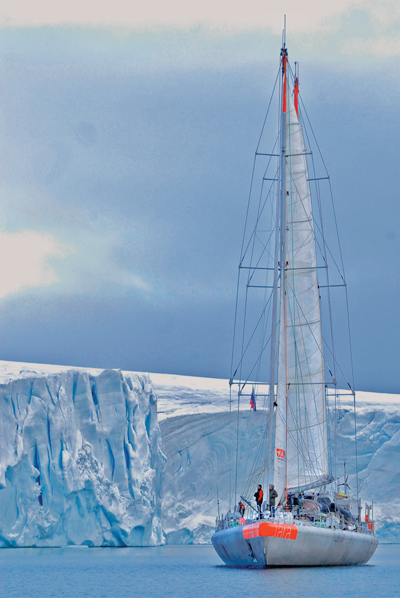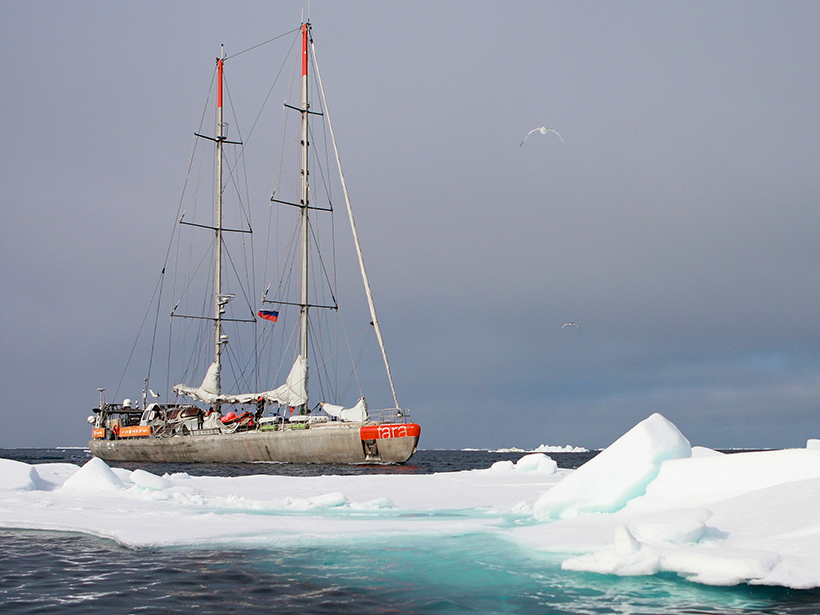Microbes are the foundation of marine ecosystems, and marine viruses shape the biodiversity, life span, and evolution of microbial communities. A recent study in Cell presented the most extensive catalog of marine viruses to date, genetically identifying more than 180,000 new viral populations around the world.
“Marine viruses infect and lyse about one third of cells per day, transfer genes from one host to another, and metabolically reprogram their hosts,” Matthew Sullivan, principal investigator on the project and a microbiologist at The Ohio State University in Columbus, told Eos. “Cataloging them helps us understand how viruses modulate the microbial processes that underpin the marine ecosystem.”
The researchers also identified five distinct ecological zones for marine viruses, including two subzones in the Arctic Circle. Advanced genetic sequencing showed that viral populations in the Arctic, the region most affected by climate change, are among the most biodiverse in the world.
“A Truly Impressive Data Set”

The researchers analyzed water samples collected by the Tara Oceans expedition, a global oceanographic research and survey effort that involved dozens of labs and hundreds of researchers, Sullivan said. The samples represent 145 ocean locations around the world, including 41 new samples from the Arctic Ocean. Each water sample hosts a unique virus habitat, or virome.
The team had analyzed some of these viromes previously and identified around 15,000 viral populations “using state-of-the-art [techniques] at the time,” Sullivan said. “This new paper then builds upon this to take advantage of deeper sequencing, new assembly algorithms, and new virus identification algorithms, which all added quite a bit to this current data set.”
By using more advanced gene sequencing methods, the team identified nearly 200,000 marine viral populations. This is a roughly twelvefold increase in the number of known marine viruses.
Ninety-two percent of the viruses the team identified were new discoveries, and about half of those new marine viruses came from the Arctic.
“This is a truly impressive data set,” said viral ecologist Joanne Emerson, who was not involved with this research. “At nearly 200,000 viral populations, the scale is astounding.” Emerson is an assistant professor at the University of California, Davis.
Defining Populations
Viral ecologists have struggled with defining the boundaries of viral species because RNA viruses and single-strand DNA viruses evolve very quickly. They typically group viruses into “populations” along a common genetic lineage, but this process requires extensive data sets of deep genetic sequencing and has been done for only a few subgroups of viruses.
“This work includes the strongest evidence thus far for a robust, broadly applicable, sequence-based definition of a viral ‘species.’”
With the new catalog, the researchers were able to test whether this approach to viral populations applies more generally. They found that, yes, it does.
“The research supports a prior definition of viral populations,” Jennifer Brum, an oceanographer and marine viral ecologist at Louisiana State University in Baton Rouge, told Eos. “This is exciting because our field has been struggling for some time with the problem of how to count different types of viruses—something that is necessary to quantitatively compare viral assemblages in various locations.”
“Without a definition for viral populations,” Brum said, “we cannot begin to assess the environmental conditions that drive their distribution, dynamics, and effects on Earth’s ecosystem.” Blum was not involved with this research.
“This work includes the strongest evidence thus far for a robust, broadly applicable, sequence-based definition of a viral ‘species,’ providing the currency to probe viral impacts on and responses to ecosystem processes,” Emerson said.
Surprising Arctic Biodiversity

The researchers also found that virus populations were grouped into five distinct ecologic zones: Arctic, Antarctic, deep sea, temperate-tropical midlevel, and temperate-tropical near surface. This grouping suggests that water temperature is a major driver in structuring viral ecologic zones, according to the researchers, which matches their earlier virus research as well as global microbial surveys.
The team then calculated the biodiversity of viral populations within each ecologic zone. They found that the Antarctic and midlevel zones had the lowest biodiversity. The near-surface zone and part of the Arctic zone were biodiversity hot spots.
The Arctic biodiversity surprised the team because current conventions assume that biodiversity decreases closer to Earth’s poles.
“Half of the oxygen we breathe comes from the oceans,” Sullivan said, “and half of the carbon dioxide that we humans release into the atmosphere is absorbed by the oceans and its marine microbes.” This marine virus catalog provides a baseline that scientists can use when evaluating the ecosystem changes caused by rising Arctic sea temperatures, he said.
“The finding from this paper that the Arctic Ocean has surprisingly high diversity of viruses is very interesting,” Brum said, “especially because that region is being significantly impacted by climate change.”
“There are a number of dots yet to be connected,” Emerson said, but the connection between sea temperature and viral biodiversity “suggests the potential for climate effects on viral communities that could ricochet through ocean food webs.”
—Kimberly M. S. Cartier (@AstroKimCartier), Staff Writer
Citation:
Cartier, K. M. S. (2019), Marine virus survey reveals biodiversity hot spots, Eos, 100, https://doi.org/10.1029/2019EO122795. Published on 03 May 2019.
Text © 2019. AGU. CC BY-NC-ND 3.0
Except where otherwise noted, images are subject to copyright. Any reuse without express permission from the copyright owner is prohibited.
Text © 2019. AGU. CC BY-NC-ND 3.0
Except where otherwise noted, images are subject to copyright. Any reuse without express permission from the copyright owner is prohibited.

